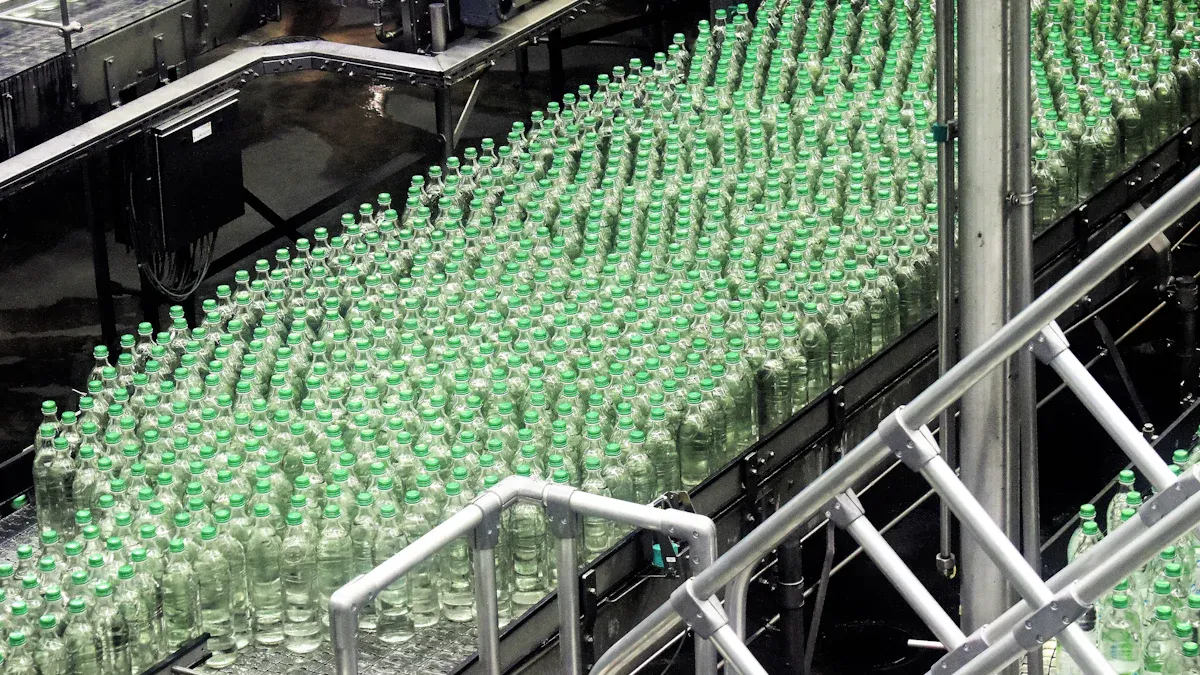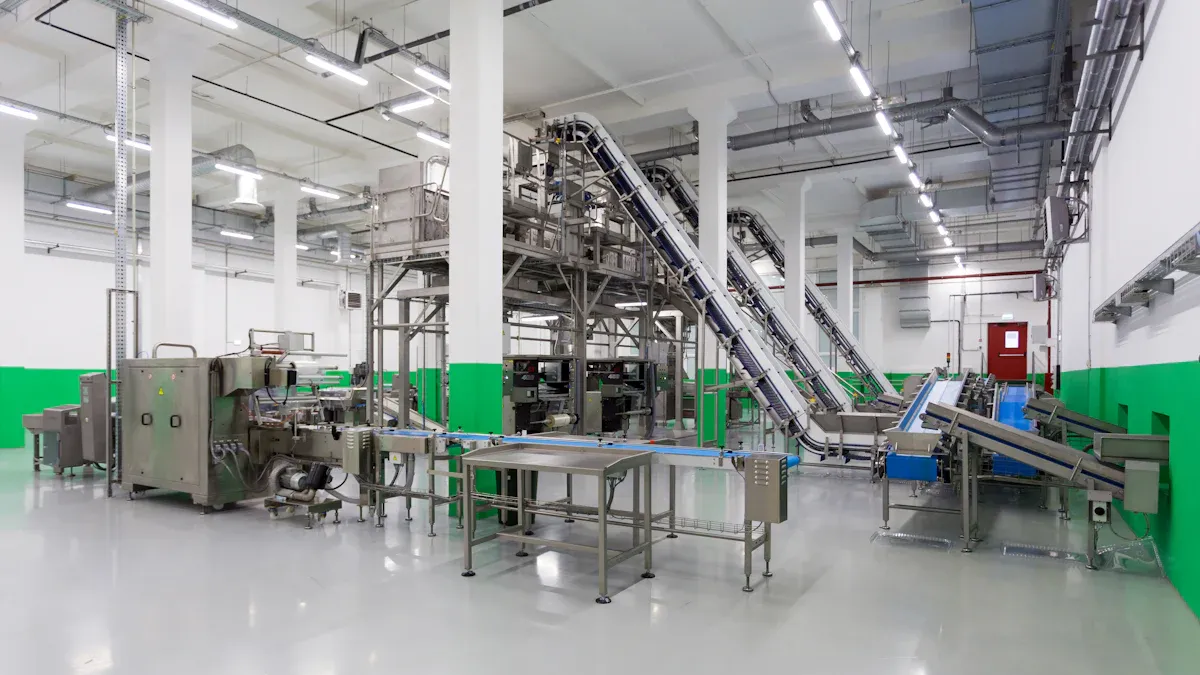
News
You can overcome energy consumption challenges in the plastics industry by using a VFD Variable Frequency converter. For example, Radius Systems, a plastic extrusion company, achieved up to 15% energy savings by upgrading its motor system. These converters optimize motor performance, reducing energy waste, maintenance costs, and noise while improving efficiency.
Key Takeaways
VFDs can cut energy use by up to 50% in pumps and compressors. This helps save a lot of money.
VFDs make motors last longer by reducing wear and tear. This lowers repair costs and makes them more dependable.
VFDs improve product quality by controlling motor speed and power. This keeps manufacturing steady and reliable.
Understanding VFDs and their role in energy efficiency
What are VFDs?
Variable Frequency Drives (VFDs) are advanced motor controllers that regulate the speed and torque of electric motors. Unlike traditional motor controllers, which operate motors at a constant speed, VFDs adjust the motor's speed based on the specific requirements of the application. This dynamic control not only improves energy efficiency but also enhances the overall performance of the motor.
Here’s a comparison to help you understand how VFDs differ from traditional motor controllers:
By offering precise speed control, VFDs allow you to tailor motor performance to the specific needs of your operation. This flexibility makes them an essential tool in industries like the plastics industry, where energy efficiency and process optimization are critical.
How VFDs optimize motor speed and reduce energy waste
VFDs enhance energy efficiency by adjusting motor speed and torque to match the actual load requirements. Motors often run at full speed even when the application doesn’t demand it, leading to unnecessary energy consumption. VFDs solve this problem by regulating the frequency and voltage supplied to the motor, ensuring it operates only as fast as needed.
For example, in the plastics industry, processes like extrusion and injection molding require precise motor control to maintain consistent product quality. VFDs provide this control while minimizing energy waste. They also offer features like soft start and stop, which gradually increase or decrease motor speed. This reduces inrush current and mechanical stress, extending the lifespan of the motor and lowering maintenance costs.
Evaluating the energy efficiency of VFDs often involves standards like IEC 61800-9-2 and IES testing. These tests measure how effectively a VFD’s motor control algorithms optimize energy use. By choosing the right VFD, you can achieve significant energy savings and improve the overall efficiency of your operations.
The impact of VFDs on energy costs and sustainability
The adoption of VFDs has a profound impact on energy costs and sustainability. By reducing energy waste, VFDs help you lower electricity bills and contribute to a greener environment. For instance, a high-quality plastic bag manufacturer that upgraded to liquid-cooled VFDs reported annual electricity savings of $20,000-$30,000. This not only reduced operational costs but also enhanced the company’s sustainability efforts.
In addition to cost savings, VFDs support sustainability by enabling precise motor control. This improves process efficiency and reduces the environmental footprint of manufacturing operations. The plastics industry, which faces increasing pressure to adopt energy-efficient technologies, benefits significantly from the use of VFDs. By integrating VFDs into your operations, you can meet energy conservation goals while maintaining high production standards.
The growing adoption of VFDs is driven by several factors, including advancements in automation, government regulations promoting energy efficiency, and the integration of IoT-enabled technologies. These trends highlight the importance of VFDs in modern manufacturing and their role in shaping a sustainable future.
Applications of VFDs in the plastics industry

Extrusion machines and energy optimization
Extrusion machines play a vital role in the plastics industry, producing pipes, sheets, and films. These machines often operate continuously, consuming significant amounts of energy. By integrating Variable Frequency Drives (VFDs), you can optimize motor performance and reduce energy consumption.
VFDs adjust motor speed based on the specific requirements of the extrusion process. For instance:
They reduce motor speed when full power is unnecessary, saving energy.
Precise control over speed ensures consistent product quality and reliability.
Soft starting and stopping minimize mechanical stress, extending the lifespan of motors and connected equipment.
Additionally, VFDs enable smoother startups and controlled acceleration, which reduces wear on machinery. This not only lowers maintenance costs but also enhances the overall efficiency of your operations. By adopting VFDs, you can achieve significant energy savings while maintaining high production standards.
Injection molding and process efficiency
Injection molding is another critical process in the plastics industry, used to manufacture a wide range of products, from small components to large containers. The use of VFDs in injection molding has been linked to remarkable efficiency improvements. These include reduced energy consumption, lower operational costs, and minimized energy loss as heat during motor operation.
A VFD allows you to control the motor's speed and torque with precision, ensuring consistent molding quality. For example:
Energy savings from VFDs in injection molding setups range between 15-40%.
Improved control over motor speed leads to better product consistency and reduced waste.
Increased production rates are possible as VFDs enable machines to operate at higher speeds when needed.
Although the initial cost of installing VFDs may seem high, the long-term benefits, including energy savings and enhanced sustainability, make them a worthwhile investment.
Blow molding and enhanced motor control
Blow molding processes, used to create hollow plastic products like bottles and containers, require precise motor control to ensure uniformity and quality. VFDs provide this control by dynamically adjusting motor speed and torque to match the demands of the process.
With a VFD, you can achieve:
Enhanced motor control, leading to consistent wall thickness in molded products.
Reduced energy consumption by operating motors only as fast as necessary.
Lower mechanical stress on equipment, which extends the lifespan of your machinery.
For example, during the cooling phase of blow molding, a VFD can slow down the motor, reducing energy use without compromising product quality. This level of control not only improves efficiency but also supports your sustainability goals by minimizing waste and energy consumption.
By incorporating VFDs into extrusion, injection molding, and blow molding processes, you can address energy consumption challenges while improving operational efficiency. These applications highlight the transformative impact of VFD technology in the plastics industry.
Liquid-cooled vs. air-cooled VFDs

Advantages of liquid-cooled VFDs
Liquid-cooled VFDs offer several benefits, especially in high-demand industrial environments. These systems use water or other coolants to dissipate heat, making them highly efficient.
Higher energy efficiency: Liquid-cooled systems generally exhibit lower specific power requirements compared to air-cooled systems. This means they consume less energy for the same output.
Compact design: These VFDs are smaller because liquid cooling is more effective at heat removal, reducing the need for bulky heat sinks.
Heat recovery potential: The cooling water can be repurposed for other processes, offsetting operational costs and improving overall efficiency.
Quiet operation: Liquid cooling minimizes noise, creating a quieter work environment.
In industrial applications, liquid-cooled VFDs can achieve energy savings exceeding 30%. Even a modest reduction in motor speed can lead to significant energy reductions, making these systems a cost-effective choice for energy-intensive operations.
Advantages of air-cooled VFDs
Air-cooled VFDs are a practical choice for many applications due to their simplicity and lower upfront costs. These systems rely on fans to dissipate heat, making them easy to install and maintain.
Cost-effectiveness: Air-cooled systems are often more economical, especially in environments where electricity and water treatment costs are high.
Ease of maintenance: With fewer components, air-cooled VFDs require less maintenance and are easier to service.
Versatility: These systems perform well in a wide range of operating conditions, making them suitable for many plastics manufacturing processes.
Although air-cooled VFDs may not match the efficiency of liquid-cooled systems, they remain a reliable option for facilities with moderate cooling needs.
Choosing the right VFD for plastics machinery
Selecting the right VFD depends on several factors. Start by identifying the specific requirements of your machinery and environment.
Evaluate the load characteristics and torque demands of your equipment.
Match the VFD to your motor's current, voltage, and power ratings.
Consider environmental factors like temperature, dust, and corrosion levels.
Define your control objectives, such as speed regulation and performance needs.
Assess the need for harmonic filters and EMI suppression to ensure smooth operation.
Prioritize safety features like overload protection and interlocks.
Ensure compatibility with existing equipment and communication protocols.
Factor in economic considerations, including installation and maintenance costs.
Look for technical support and favorable warranty terms.
Confirm compliance with industry standards like AHRI 1210 and 1211 for reliability and performance.
By carefully evaluating these criteria, you can choose a VFD that meets your operational needs while optimizing energy efficiency and reliability.
Key benefits of VFDs in the plastics industry
Energy savings and cost reduction
Using VFDs can significantly lower energy consumption and operational costs. By adjusting motor speed to match the actual load, VFDs prevent unnecessary energy use. For example, blower motors equipped with VFDs consume 10-20% less electricity, while pumps in high-demand applications like water treatment can reduce energy usage by up to 50%. These savings directly translate into reduced electricity bills, making VFDs a cost-effective solution for energy-intensive industries.
In the plastics industry, where processes like extrusion and injection molding require continuous operation, energy efficiency is crucial. VFDs not only optimize motor performance but also help you achieve measurable cost reductions. For instance, industries like mining and metals have reported energy savings exceeding 30%, with some technologies paying for themselves in less than six months.
Reduced motor wear and maintenance costs
VFDs extend the lifespan of motors by minimizing mechanical stress. Traditional motor systems often experience wear due to abrupt starts and stops. In contrast, VFDs offer soft-start capabilities, gradually increasing motor speed to reduce mechanical shock. This smoother operation decreases the likelihood of equipment failure and lowers maintenance expenses.
Additionally, VFDs improve motor efficiency by reducing unnecessary strain during operation. This not only enhances reliability but also reduces downtime, ensuring your production processes remain uninterrupted. By investing in VFD technology, you can save on repair costs and increase the longevity of your machinery.
Improved process control and product quality
Precise motor control is essential for maintaining consistent product quality in the plastics industry. VFDs allow you to fine-tune motor speed and torque, ensuring optimal performance for processes like injection molding and blow molding. This level of control helps you produce uniform products with minimal defects.
For example, VFDs enable consistent wall thickness in blow-molded products and precise temperature control in extrusion processes. These improvements enhance product quality while reducing material waste. By integrating VFDs into your operations, you can achieve better process efficiency and meet high production standards.
Variable Frequency Drives (VFDs) are indispensable for addressing energy consumption challenges in the plastics industry. Their ability to optimize motor performance delivers measurable benefits:
Energy efficiency: VFDs can reduce power usage by up to 25% in applications like pumps and compressors.
Widespread impact: Electric-powered motors, which consume 45% of electricity in industrial settings, benefit significantly from VFD integration.energy savings of 30-50%
By adopting VFD technology, you can enhance efficiency, reduce costs, and achieve sustainability goals. Their applications in extrusion, injection molding, and blow molding underscore their versatility and transformative impact.
FAQ
What industries benefit the most from VFDs?
Industries like plastics, manufacturing, HVAC, and water treatment benefit significantly. VFDs optimize motor performance, reduce energy consumption, and improve operational efficiency across these sectors. ????
Are VFDs difficult to install?
No, VFDs are relatively easy to install. Manufacturers provide detailed instructions, and many systems integrate seamlessly with existing equipment. Professional assistance ensures proper setup. ????️
How do VFDs contribute to sustainability?
VFDs reduce energy waste by matching motor speed to load requirements. This lowers electricity usage, decreases carbon emissions, and supports your sustainability goals. ♻️
Please give us a message